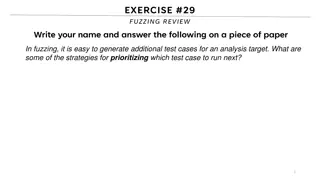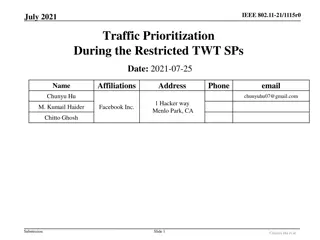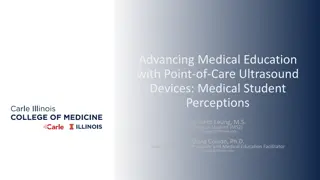Prioritization of Medical Devices: Criticality Assessment and Maintenance Strategies
Hospitals need to establish a robust Medical Equipment Management Program to ensure the safety and reliability of critical medical devices. Reliability-centered maintenance (RCM) and Failure Mode and Effect Analysis (FMEA) are essential processes to determine maintenance requirements. Asset criticality analysis helps in prioritizing maintenance for critical assets, utilizing methodologies like the Probability Risk Number (PRN). By assessing the operational impact and importance of devices, organizations can effectively manage their medical equipment.
Download Presentation

Please find below an Image/Link to download the presentation.
The content on the website is provided AS IS for your information and personal use only. It may not be sold, licensed, or shared on other websites without obtaining consent from the author.If you encounter any issues during the download, it is possible that the publisher has removed the file from their server.
You are allowed to download the files provided on this website for personal or commercial use, subject to the condition that they are used lawfully. All files are the property of their respective owners.
The content on the website is provided AS IS for your information and personal use only. It may not be sold, licensed, or shared on other websites without obtaining consent from the author.
E N D
Presentation Transcript
PRIORITIZATION OF MEDICAL DEVICES
LITERATURE REVIEW The ever-increasing number and complexity of medical devices demands that hospitals establish and regulate a medical equipment management program (MEMP) to ensure that critical devices are safe and reliable and that they operate at the required level of performance. As fundamental aspects of this program inspection, preventive maintenance, and testing of medical equipment should be reviewed continuously to keep up with today s technological improvements and the increasing expectations of healthcare organizations.
LITERATURE REVIEW Reliability centered maintenance (RCM). RCM is a structured methodology for determining the maintenance requirement of a physical asset in its operating context through a thorough and rigorous decision process, as shown in figure 3.1
Steps 2 to 5 in figure 3.1 show the process of Failure Mode and Effect Analysis (FMEA). The results of FMEA are used to select appropriate maintenance tactics using RCM logic for the various functional failures. Asset criticality analysis is the first step of applying RCM in an organization, especially when a large number of different devices exist and the worst problems in terms of failure consequences are not obvious.
Criticality is a relative measure of the importance of an object based on some factors considered in a particular context. Asset criticality is a function of the operational impact to the organization s mission due to the loss, damage, or destruction of an asset .Dekker et al (1998) define the equipment criticality as a function of the use of equipment, rather than of equipment itself and explain how a certain device may be in one case critical and in another auxiliary.
Significant and critical assets should be identified and prioritized, and many techniques have been developed for criticality assessment of devices. Most use some variation of the Probability Risk Number or PRN ,a product of the probability of failure of an asset, severity of the consequence of the failure, and detectability of the failure: PRN = probability of failure x severity x detectability
Fennigkoh and smith (1989) proposed a risk assessment method to group medical devices on the basis of their Equipment Management (EM) numbers, or the sum of the numbers assigned to the device s critical function, physical risk, and required maintenance: EM= critical function + physical risk + required maintenance. (3.2) Devices with an EM number above a critical value ( 12) are considered to have critical risk and thus are included in inspection and maintenance plans.
Clinical engineers believe that risk is not the only inclusion criterion, however, even though it is the most important one. Other criteria which reflect the needs and reality of a hospital should be considered, including mission criticality, availability of backup, hazard notice, and recall history
MODEL FOR PRIORITIZATION OF MEDICAL DEVICES We present a multi-criteria decision-making model, which can be used to prioritize medical devices and establish guidelines for selecting appropriate maintenance strategies. Multi-Criteria Decision Making (MCDM) is a well-known branch of decision making, divided into multi-objective and multi-attribute decision making. A Multi- Attribute Decision Making (MADM) is making preference decisions such as evaluation, prioritization, and selection over available alternatives, characterized by multiple attributes
MODEL FOR PRIORITIZATION OF MEDICAL DEVICES Analytical hierarchy process (AHP) is a three-step process. 1- it decomposes a complex problem into a hierarchy, in which the overall decision objective lies at the top and the criteria, sub-criteria and decision alternatives are on each descending level of the hierarchy compose of specific factors. 2- decision makers then compare each factor to all other factors at the same level of the hierarchy using a pairwise comparison matrix to find its weight or relative importance. 3- the optimal solution is the alternative with the greatest cumulative weight
MODEL FOR PRIORITIZATION OF MEDICAL DEVICES Two types of comparisons can be employed in the AHP: absolute and relative measurements. In absolute comparison, alternatives are compared with a standard in one s memory that has been developed through experience. In relative measurement, alternatives are compared in pairs according to a common attribute. As a result, in absolute measurement, the rank of alternatives does not reverse when new alternatives are introduced, or the old ones are deleted; however, the priority of alternatives may change by altering the existing set of alternatives
PROPOSED CRITICALITY ASSESSMENT MODEL FOR MEDICAL EQUIPMENT We consider criticality prioritization of medical devices as a MCDM problem and use AHP to solve it. The objective is to identify and include the more critical devices in the equipment management program of a hospital, and investigate in details the reasons of having high criticality scores to take appropriate actions, such as preventive maintenance , user training , redesigning the device , etc. When reducing the criticality score is applicable and manageable.
PROPOSED CRITICALITY ASSESSMENT MODEL FOR MEDICAL EQUIPMENT
PROPOSED CRITICALITY ASSESSMENT MODEL FOR MEDICAL EQUIPMENT The weight of each criterion is determined by comparing its relative contribution to the goal (prioritization of medical devices) with other assessment criteria. Therefore, if a new criterion is added or an existing one is deleted from the hierarchy, all criteria should be reassessed to find their new weights. To be able to assess a device with respect to a criterion, the criterion s grades and their associated intensities should be defined in advance. The grades are possible categories or classes of a criterion. For example, old , average , and new can be considered as three classes of a device s age. The definition of each class should be decided and concurred by the decision makers. The decision makers may consider a device as new when its actual age is 25% of its expected life span
PROPOSED CRITICALITY ASSESSMENT MODEL FOR MEDICAL EQUIPMENT The proposed model can be summarized in the following steps: 1- identify all sufficient, efficient and independent criteria and sub-criteria for criticality assessment of devices. 2- determine weighting values for all criteria and sub-criteria using relative measurement method. 3- set up grades and determine intensities for each criterion using relative measurement method. 4- evaluate alternatives (devices or failure modes) with respect to each criterion, and assign the most descriptive grades using absolute measurement method; the assigned grade s intensity for an alternative is called its score with respect to a criterion.
PROPOSED CRITICALITY ASSESSMENT MODEL FOR MEDICAL EQUIPMENT
PROPOSED CRITICALITY ASSESSMENT MODEL FOR MEDICAL EQUIPMENT Order devices according to their criticality scores. In our proposed model (figure 3.2), six criteria are identified at the top level. Some of these should be divided into sub-criteria; we divide mission criticality into utilization and availability of alternative devices . Figures 3.3 and 3.4 show associated mission criticality and risk sub-criteria.
PROPOSED CRITICALITY ASSESSMENT MODEL FOR MEDICAL EQUIPMENT
DESCRIPTIONS OF CRITERIA AND SUB-CRITERIA C1. Function The function of a device is the main purpose for which it is to be used Risk or consequence of a device failure should not be confused with its function, thus we propose in our model life support , therapeutic , patient diagnostic , analytical , and miscellaneous as function categories.
DESCRIPTIONS OF CRITERIA AND SUB-CRITERIA C2. Mission criticality Mission criticality or operational impact describes the extent to which a device is crucial to the care delivery process of a hospital. For example, magnetic resonance imaging (MRI) equipment might be extremely significant according to the mission of a hospital but less critical in terms of its function or potential risk through use. Wang (atles, 2008) suggests classification of devices in three groups (critical, important, and necessary) according to their mission criticality. In our model, mission criticality depends on utilization and availability of similar or alternative devices
DESCRIPTIONS OF CRITERIA AND SUB-CRITERIA C21. Utilization Utilization shows the total hours a device is used on average in a hospital (hours per day or days per week or weeks per year). In this model, we consider the average hours a device is used per week as the utilization criterion. Utilization can be defined as a function of average usage and the number of patients served per unit time. Obviously, incorporating the number of patients into the model makes calculation of utilization more complicated.
DESCRIPTIONS OF CRITERIA AND SUB-CRITERIA C22. Availability of alternative devices It should be noted that having several similar devices does not always mean high availability of alternative devices: the demand per unit time of these devices is also important. If there are several similar devices in a hospital but all are highly utilized, if either fails, there is less chance that others can be used as substitutes. Therefore, availability of alternative devices Can be considered as a function of the number of similar or backup devices and their demand per unit time.
DESCRIPTIONS OF CRITERIA AND SUB-CRITERIA C3. Age Age score is based on the actual age of a device and its predictable life span. The life span for a group of similar devices can be obtained from the literature. In general, ten years is the average life span of a medical device
DESCRIPTIONS OF CRITERIA AND SUB-CRITERIA C4. Risk The risk of a device should be an aggregate of all risk values estimated from the actual failures, which have occurred in the device. All failure modes and their associated frequencies, consequences, and detectabilities should be extracted or estimated from data history and device maintenance work orders. The risk value can then be estimated as a function of frequency, consequence, and detectability for each failure mode. In short, the risk of the device is the total risk of all its failure modes.
DESCRIPTIONS OF CRITERIA AND SUB-CRITERIA C41. Failure frequency Failure frequency is the likelihood of a failure occurrence. The VA national center for patient safety has designed healthcare failure modes and effects analysis (HFMEA) specifically for healthcare. Their suggested failure frequency rating scales
DESCRIPTIONS OF CRITERIA AND SUB-CRITERIA C42. Detectability Failure detectability is the ability to detect a failure when it occurs. In the proposed model, we use the detectability levels. C43. Failure consequence To find the total consequences of each failure mode, its operational, non- operational, and safety and environment impacts should be assessed. These three categories are the conventional failures consequences used in the RCM terminology, so we keep this level although both operational and non-operational criteria have only one related sub-criteria in our model, as follows.
DESCRIPTIONS OF CRITERIA AND SUB-CRITERIA C431. Operational Operational consequence of a failure is its impact on the care delivery process of a hospital. C4311. Downtime Downtime is generally the average time that a device is out of service. However, for medical devices it is also important to consider the number of patients who have to wait while the device is down. We therefore suggest the average of the total waiting time of all patients as downtime sub-criteria, considering both the number of patients and the length of time they wait due to device failure.
DESCRIPTIONS OF CRITERIA AND SUB-CRITERIA C432. Non-operational Non-operational consequence of a failure is its direct inspection and repair cost, including man power and spare part(s) . C4321. Cost of repair Cost of repair is the sum of labor and spare part(s) costs incurred by fixing a failure or defect. Grade classification (i.e. High, medium, and low) for cost of repair depends on the budget of a hospital and the purchase price of devices.
DESCRIPTIONS OF CRITERIA AND SUB-CRITERIA C433. Safety and environment Safety and environment consequences of a failure are critical impacts that should be taken into account. C5. Recalls and hazard alerts The number and class of recalls and the number of hazard alerts that may occur for a device are important criteria in prioritization of medical devices. U.S. Food and drug administration (FDA) guidelines categorize recalls into three classes according to the level of hazard involved
DESCRIPTIONS OF CRITERIA AND SUB-CRITERIA C6. Maintenance Requirements according to fennigkoh and smith (1989), equipment that is predominantly mechanical, pneumatic, or fluidic often requires the most extensive maintenance. A device is considered to have an average maintenance requirement if it requires only performance verification and safety testing. Equipment that receives only visual inspection, a basic performance check, and safety testing is classified as having minimal maintenance requirements.
DETERMINING WEIGHTING VALUES FOR CRITERIA AND SUB-CRITERIA Once all criteria and sub-criteria have been identified, their relative importance can be determined with respect to their goal or their upper-lever criterion using saaty s eigenvector technique. In other words, relative AHP is employed to determine criteria and sub-criteria weighting values. Table 3.1 shows the weighting values calculated for all criteria and sub-criteria in the model. The values given here represent expert opinion; results may differ with the participation of a different group of experts.
DETERMINING WEIGHTING VALUES FOR CRITERIA AND SUB-CRITERIA
RANKING MEDICAL DEVICES Each device should be assessed with respect to every covering criterion, the lowest level criterion or sub-criterion connected to the alternatives (saaty, 2008) and assigned an appropriate grade. The score of a device at a criterion that has sub- criteria is then the sum product of the sub-criteria s weights and their grades intensities assigned to the device. This part of the AHP process is called synthesizing (saaty, 2008). Therefore, the total score for a device can be obtained as an absolute value from the weighted sum of the main criteria and their assigned intensities for the device. In order to easily prioritize and classify devices according to their score values, the absolute total score values should be normalized by dividing the total score values by the maximum of all devices score values























